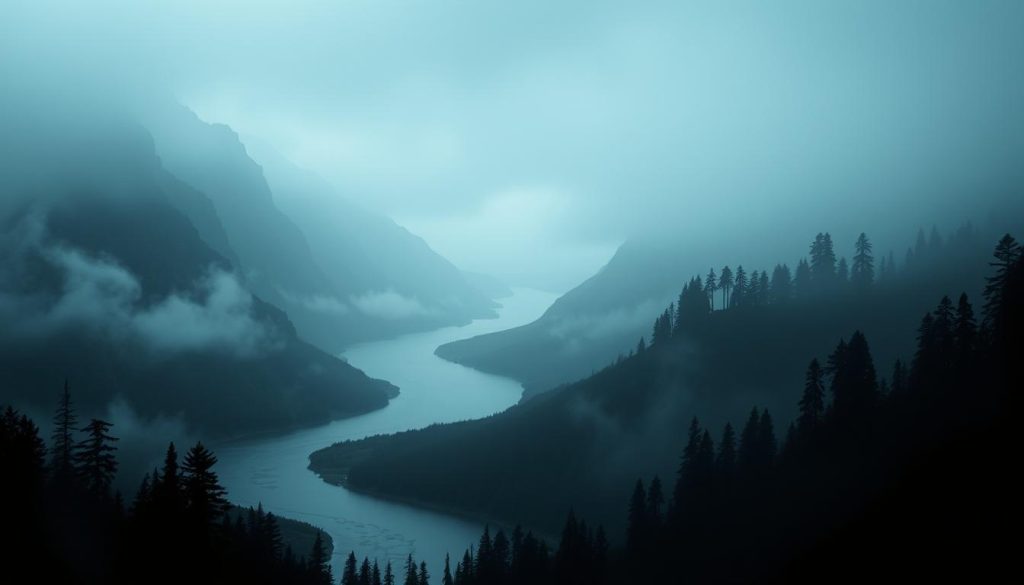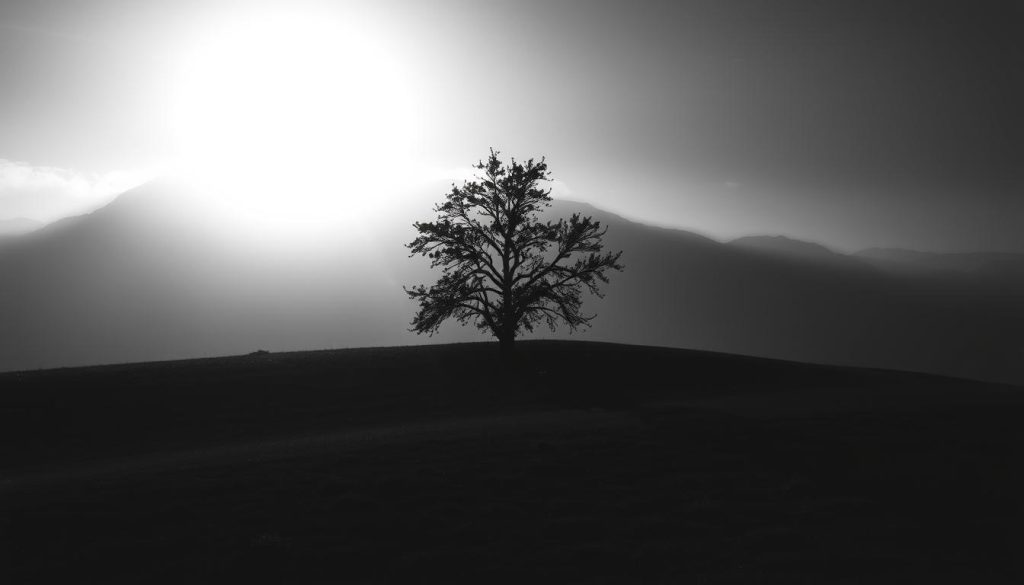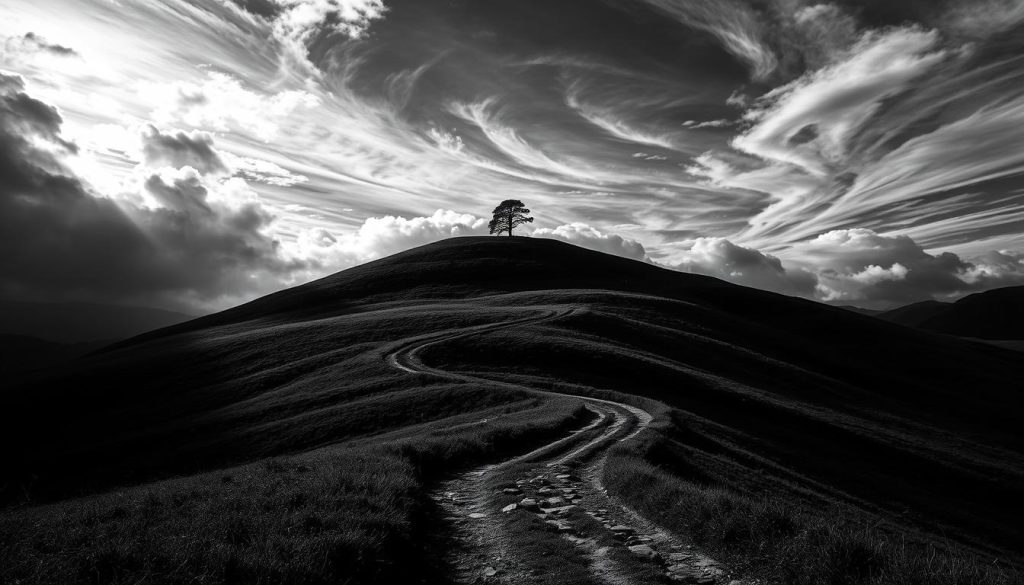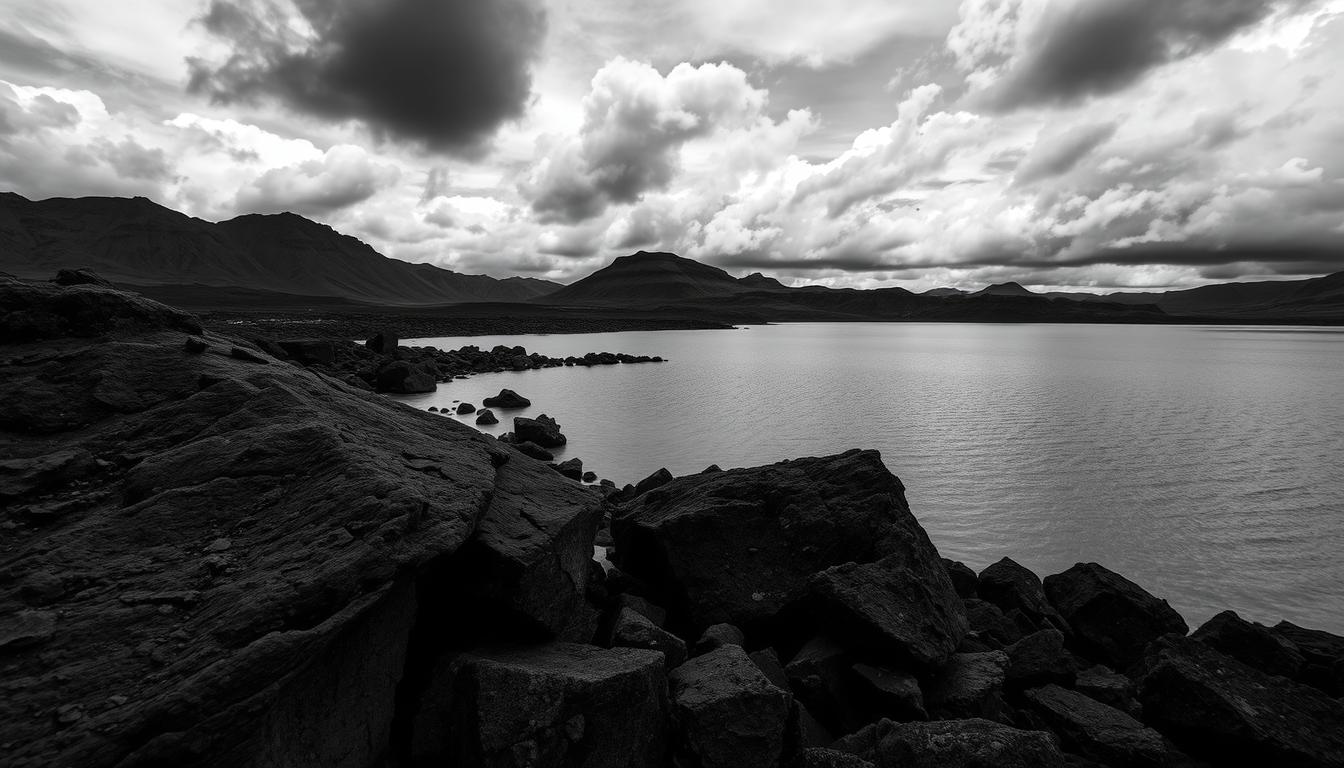I love black and white photography. It’s simple yet powerful. It lets us see the real beauty of a scene. In this guide, I’ll teach you how to take amazing black and white photos.
Whether you’re new or experienced, this article will help you improve. You’ll learn about the beauty of black and white. And how to use light and shadow to create stunning images.
You’ll discover how to set up scenes and control light. You’ll also learn to enhance your photos in post-processing. By the end, you’ll know how to capture the true essence of your subjects in black and white.
Unveiling the Artistry of Black and White Photography
In the world of monochrome photography, black and white images stand out. They let us see the power of light, shadow, and form. This is the heart of visual storytelling.
Monochrome photography gives us a special way to make images. These images grab the viewer and feel timeless and artistic.
The Timeless Appeal of Monochrome Imagery
Monochrome photography has a timeless charm. It uses highlights and shadows to speak to us on a deep level. Without color, we notice tone, texture, and contrast more.
This lets us see our subjects in a raw, true way. It’s a powerful way to connect with the viewer.
Harnessing the Power of Light and Shadow
In monochrome photography, light and shadow are key. We use them to shape our subjects and create mood. This brings depth and dimension to our images.
Whether it’s a cityscape or a landscape, black and white photography lets us create something beyond reality. It’s a way to make images that touch the soul.
By exploring grayscale photography, we unlock a world of fine art photography and minimalist photography. These images speak to us on a deep emotional level. Let’s dive into the art of monochrome and make images that last forever.
Monochrome photography techniques: Unleashing Creativity

Exploring creative monochrome photography opens a world of endless possibilities. It ranges from the captivating minimalist style to the striking fine art photography. Black and white images offer a canvas for boundless artistic expression.
Discover the power of contrast, negative space, and abstract elements in experimental photography. Learn to create visually stunning monochrome masterpieces. High-contrast compositions, with bold lines and dramatic shadows, add drama and emotion.
Step into abstract photography and unleash your creativity. Play with forms, textures, and patterns to transform the ordinary into the extraordinary. Embrace simplicity and let light and shade guide your vision.
Whether you love documentary-style monochrome or architectural photography, this section has insights and inspiration. It helps you push the boundaries of your creative monochrome photography. Unlock your artistic expression and create lasting impressions.
| Technique | Description | Benefits |
|---|---|---|
| High-Contrast Compositions | Leveraging bold lines, shadows, and dramatic contrasts to create a sense of depth and emotion | Enhances the visual impact of monochrome images, adds drama and intensity |
| Minimalist Photography | Embracing negative space and simplicity to create refined, elegant compositions | Focuses the viewer’s attention on the essential elements, evokes a sense of serenity and contemplation |
| Abstract Experimentation | Exploring forms, textures, and patterns to transform the ordinary into the extraordinary | Encourages creative exploration, allows for unique and captivating interpretations of the subject matter |
Mastering Exposure for Stunning Monochrome Results

In the world of monochrome photography, getting the exposure right is key. Without color, the contrast and tonal values become even more important. Learning how to control exposure can make your black and white photos truly stand out.
The Importance of Metering for Monochrome Photography
Getting the metering right is the first step to amazing monochrome photos. Using spot metering, exposure compensation, and other techniques helps you get the right balance. This lets you create images that are full of light and shadow.
Spot metering lets you measure the light of specific parts of your photo. Exposure compensation helps adjust the overall light, making your photos pop in high-contrast or low-key settings.
By mastering these techniques, you can take photos that grab your audience’s attention. Explore metering and exposure control to make your monochrome photos truly shine.
Composing Compelling Black and White Photographs

Making great monochrome photos takes a sharp eye for composition. As a pro photographer, I’ve learned to use negative space, leading lines, and light and shadow. These help make black and white photos stand out.
Whether you like simple, dramatic, or documentary photos, knowing composition is key. It helps you control the viewer’s view and create strong feelings.
Great monochrome photography composition balances and creates tension. Using light and shadow adds depth and drama, pulling the viewer in.
The way you frame your photos in black and white photography matters a lot. A simple or off-center frame can change how the viewer feels and sees your photo.
If you prefer minimalist photography composition, negative space is powerful. It makes your subject stand out with simplicity and elegance.
For a fine art photography composition style, use symmetry and light and shadow. This makes your photos both beautiful and touching.
Those who like documentary photography composition focus on capturing a scene’s essence. Good framing and element placement turn a simple photo into something powerful.
No matter your style, mastering monochrome composition is a journey. Keep trying new things and pushing your creativity. This way, you can make black and white photos that move and inspire people.
Post-Processing: Enhancing Your Monochrome Masterpieces
As a passionate photographer, I know the power of post-processing. It unlocks the true potential of your monochrome images. Whether you’re working on monochrome photography editing, black and white photography post-processing, or grayscale photography adjustments, this stage is where you can bring your vision to life.
Essential Editing Techniques for Monochrome Images
I’ll share my expertise on essential editing techniques. These can elevate your fine art photography editing and minimalist photography editing to new heights. You’ll learn how to refine your black and white images and transform them into stunning monochrome masterpieces.
- Adjusting Contrast: Enhancing the interplay of light and shadow to create depth and drama.
- Manipulating Tonality: Crafting a captivating grayscale palette that reflects your artistic vision.
- Sharpening and Clarity: Ensuring your images have the perfect level of detail and edge definition.
- Dodging and Burning: Selectively lightening or darkening specific areas to guide the viewer’s eye.
- Fine-tuning Composition: Making subtle adjustments to strengthen the overall visual impact.
Whether you’re working in Photoshop, Lightroom, or any other editing software, these techniques will become your invaluable tools. They will help you transform your raw captures into truly mesmerizing monochrome masterpieces.
Finding Inspiration in Everyday Scenes
Monochrome photography lets us see beauty in the ordinary. It turns the everyday into something special. As a photographer, I’ve learned to find inspiration in the scenes around me.
From city textures to nature’s calm, there’s much to capture. The key is to observe carefully. Look for light, shadow, and patterns in what you see.
By doing this, you can find poetry in the world. Whether you love documentary photography, street photography, or landscape photography, there’s endless inspiration. You can make ordinary scenes into art, sharing your view of the world.
Start your monochrome photography journey with an open mind. Look for subjects that match your vision. Try new things and follow your instincts. With effort, you’ll create standout images.
Embracing the Challenges of Monochrome Photography
Monochrome photography is beautiful and elegant, but it has its own set of challenges. As a photographer, I’ve learned to face these obstacles head-on. I’m excited to share the strategies that have helped me overcome them.
Essential Editing Techniques for Monochrome Images
One big challenge in monochrome photography is losing color. This can make an image feel flat or lacking in depth. To fix this, I’ve learned to use editing techniques like adjusting contrast and sharpening.
These techniques can make your black and white images come alive. By playing with tones and textures, you can add depth and drama. This makes your monochrome photos truly stand out.
Another important thing in monochrome photography is using high-contrast and low-key techniques. It can be tricky to get right, but with practice, you’ll find new ways to be creative. By working within the limits of grayscale, you can explore new levels of artistry in minimalist and fine art photography.

